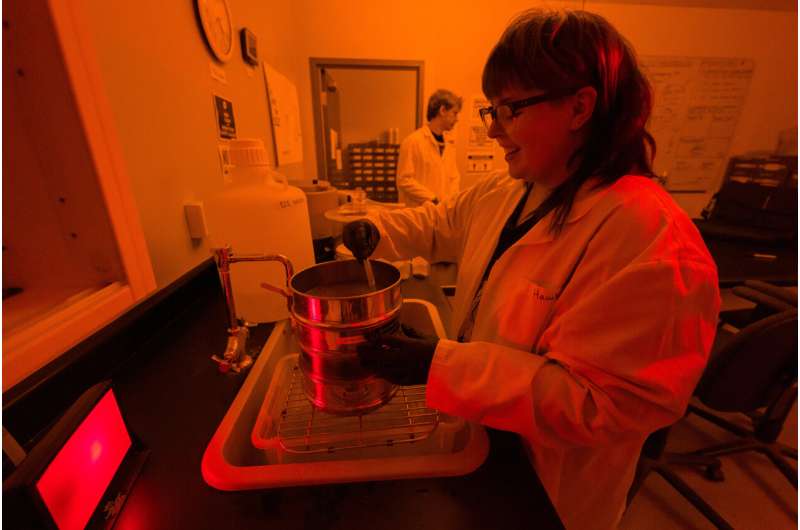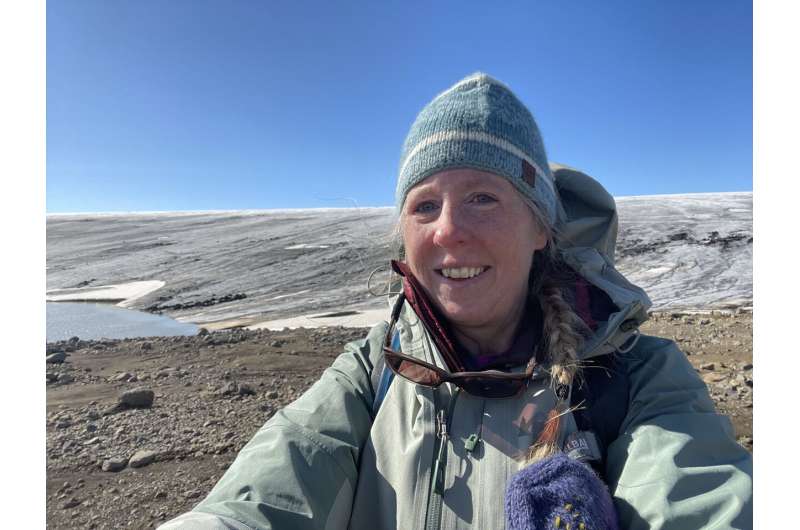This article has been reviewed according to Science X's editorial process and policies. Editors have highlighted the following attributes while ensuring the content's credibility:
fact-checked
peer-reviewed publication
trusted source
proofread
Greenland has greener history than previously thought

New analysis of samples collected from underneath Greenland's ice sheet reveal the Arctic island was much greener as recently as 416,000 years ago. The findings overturn previous views that Greenland's continental glacier, which covers about 80 percent of the 836,3000-square-mile land mass, has persisted for the last two and a half million years.
"We're discovering the ice sheet is much more sensitive to climate change than we previously thought," says Utah State University geoscientist Tammy Rittenour. "This is a foreboding wake-up call."
Rittenour, with colleagues from the University of Vermont and fourteen other institutions, reports findings in the July 20, 2023, issue of the journal Science.
A greener Greenland means the island's formidable-appearing ice sheet—nearly two miles thick in places—is not as stable as it appears.
"We had always assumed the ice sheet has remained about the same for nearly 2.5 million years," says Rittenour, professor in USU's Department of Geosciences. "But our investigation indicates it melted enough to allow the growth of moss, shrubs and buzzing insects during an interglacial period called Marine Isotope Stage 11, between 424,000 to 374,000 years ago."
The melting caused at least five feet of sea-level rise around the globe, she says. "Some of our model scenarios suggest sea levels up to 20 feet higher than today."
"It was an unusually long period of warming with moderately elevated levels of carbon dioxide—CO2—in the atmosphere," Rittenour says. "What's alarming about this finding is today's CO2 levels are 1.5 times higher."

Even if humans abruptly stopped activities that contribute to greenhouse gas emissions, she says, "we'd still have inflated CO2 levels for hundreds, maybe even thousands, of years to come."
That's an uneasy realization, she says, with current rates at which Greenland's ice sheet is thawing.
"And that's not taking Antarctica and other glacial areas into consideration," Rittenour says. "The deglaciation has implications for the entire globe and is especially sobering for our coastal mega-cities, where so much of the world's population resides."
The team's analysis is a continuation of research started several years ago, when the scientists happened upon samples collected from an extraordinary, Cold War-era military project.
"In 1960, the U.S. Army launched a top-secret effort called Project Iceworm in northwestern Greenland to build a network of mobile nuclear launch sites under the ice sheet," Rittenour says. "As part of that project, they also invited scientists and engineers to conduct experiments in a highly publicized 'cover' project, known as Camp Century, to study the feasibility of working and carrying out military missions under ice and in extreme-cold conditions."
Hampered by brutal blizzards and unstable ice conditions, Project Iceworm's cavernous underground bunker and tunnels were abandoned in 1966. But sediment samples collected at the bottom of a more than 4,000-foot-long ice core extracted from the site have yielded the surprising information about Greenland's not-so-distant geologic past.
The frozen soil samples from the base of the Camp Century ice core were forgotten in a freezer for decades, until recently re-discovered.
"We have very few samples from below the Greenland ice sheet, because most drilling missions stop when they reach the base of the ice," Rittenour says. "These re-discovered Camp Century sediments represent a unique, unspoiled time capsule of past conditions."
While the frozen soil sat in a freezer for more than 60 years, science technology advanced. Rittenour, who is director of the USU Luminescence Laboratory, was invited to help date the sediment.
"Because the samples remained frozen and largely untouched, I was able to use luminescence dating to determine the last time they were exposed to sunlight," she says. "If researchers had examined the sediments in the past, we couldn't have run any of the analyses we did for this paper."
Rittenour says today's investigative technologies enable researchers to distill a good record of what's happened in Greenland and other parts of the world.
"These once lost, Cold War relics from a top-secret nuclear military base carved within the ice are continuing to tell their secrets, and forewarn us of the sensitivity of Earth's climate," she says. "If we can lose the far northwest portion of the Greenland ice sheet under natural conditions, then we're treading dangerous waters given current elevated greenhouse gas conditions."
More information: Andrew J. Christ et al, Deglaciation of northwestern Greenland during Marine Isotope Stage 11, Science (2023). DOI: 10.1126/science.ade4248
Journal information: Science
Provided by Utah State University




















